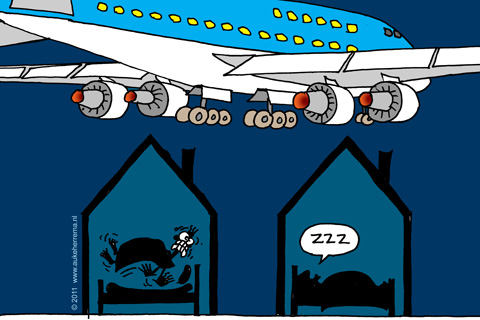Why do some people complain about aircraft noise while their neighbours do not? Dr Maarten Kroesen discovered that mistrust and loss of control intensify the impact of noise.
While the number of people subjected to aircraft noise around Schiphol airport has decreased over the past decades, the number of complaints has increased. Dr Maarten Kroesen, from the faculty of Technology, Policy and Management, was intrigued and wanted to solve this Schiphol enigma. His PhD thesis shows why some people regard noise as a hindrance while others don’t.
“When you say the annoyance is all in one’s head, people think you accuse them of posing the problem,” says Kroesen. “Instead of that, I want to make people’s experience more objective, as something to be reckoned with.”
The psychological basis for his research comes from Christian Bröer (University of Amsterdam) who argues that people give a certain meaning to aircraft noise. This significance depends on, among other things, people’s attitude towards Schiphol (‘engine of the economy’) and the environment (‘aviation is a threat to environment’). Kroesen conducted a survey on people’s attitudes and thus provided a quantitative backing for Bröer’s theory. About a third of the respondents were very supportive of Schiphol (and unlikely to make complaints about aircraft noise), while a quarter of the total were environmentally orientated, although they did accept Schiphol’s economic importance.
Kroesen discovered that two factors especially govern human response to aircraft noise: mistrust and control. Mistrust has grown over the years as noise limits were repeatedly surpassed and consequently adjusted. “People got the feeling that the economy wins out every time.” Thus people lose faith in surveys, in noise calculations and in the government, which doesn’t adhere to its own noise limits. “Overrunning noise limits is a case for the courts,” says Kroesen, “not for Parliament.”
Also, people tend to complain more about things they do not have control over. Giving people a say in how to insulate their homes from noise might improve that, Kroesen advises.
Dr Maarten Kroesen, ‘Human Response to Aircraft Noise’, 9 June 2011, PhD supervisor Prof. Bert van Wee.
Name: Hemant Sharma (25)
Nationality: Indian
Promoter: Professor Jilt Sietsma (faculty of Mechanical, Maritime and Materials Engineering, section microstructure control in metals)
Subject: Fabrication of high temperature resistant steel
Thesis defense: In two years
“I broke my leg ten years ago, and it was repaired with a plate of titanium – a very thin piece. Since then I have been fascinated with metals.
I develop steels that can resist high temperatures. The best steel that exists today can withstand up to 650°C before it starts to weaken. This record is held by Japanese researchers, but we are now in the process of making a steel alloy that is better than that. My project involves a number of steel companies, including Arcelor Mittal and Corus. The ultimate goal is to make steel that can resist 1100°C, which of course is a very big challenge.
The World Trade Center towers collapsed when the temperature went beyond 550°C. Those buildings were in fact designed to withstand higher temperatures, since the steel was covered with a fire-resistant coating, but due to the explosions the coating was blown away.
If we can make steel stronger, we wouldn’t need coatings, which cost as much as the steel itself and need to be replaced routinely, and thus we could make buildings that are more resistant to fires and are cheaper.
Steel is made out of grains, small crystallites the size of a few micrometers. The smaller these are, the stronger the steel. When the metal is heated, these grains begin to grow. One way to prevent the grains from growing is by adding atoms of elements, like carbon, niobium, copper or titanium, to the metal. When the steel heats up, these atoms combine to form nanoparticles. These nanoparticles slow down the growth of the grains. So you could say that we develop a smart material which can adapt to conditions during a fire.
To study the growth of the grains in the presence of the nanoparticles, we look inside the opaque steel with synchrotron radiation, a very intense beam of high energy X-rays. We do this using the 3-Dimensional X-Ray Diffraction Microscope at the European Synchrotron Radiation Facility (ESRF) in Grenoble, France. This is a particle accelerator specially tuned for generating high intensity x-rays. We go there to conduct experiments around four times per year.
In order to control the experiments very accurately, we have developed a special furnace – for dedicated use at the supermicroscope – for accurate temperature control of the steel samples, which are the size of the lead of a pencil.
After I have finished my PhD, I’d like to continue conducting fundamental research. I don’t like industrial, profit-driven projects very much. I want to understand what happens inside metals on the very fundamental level.
“Maybe I will stay here and do a postdoc. On the other hand, I miss Indian food a lot.”



Comments are closed.